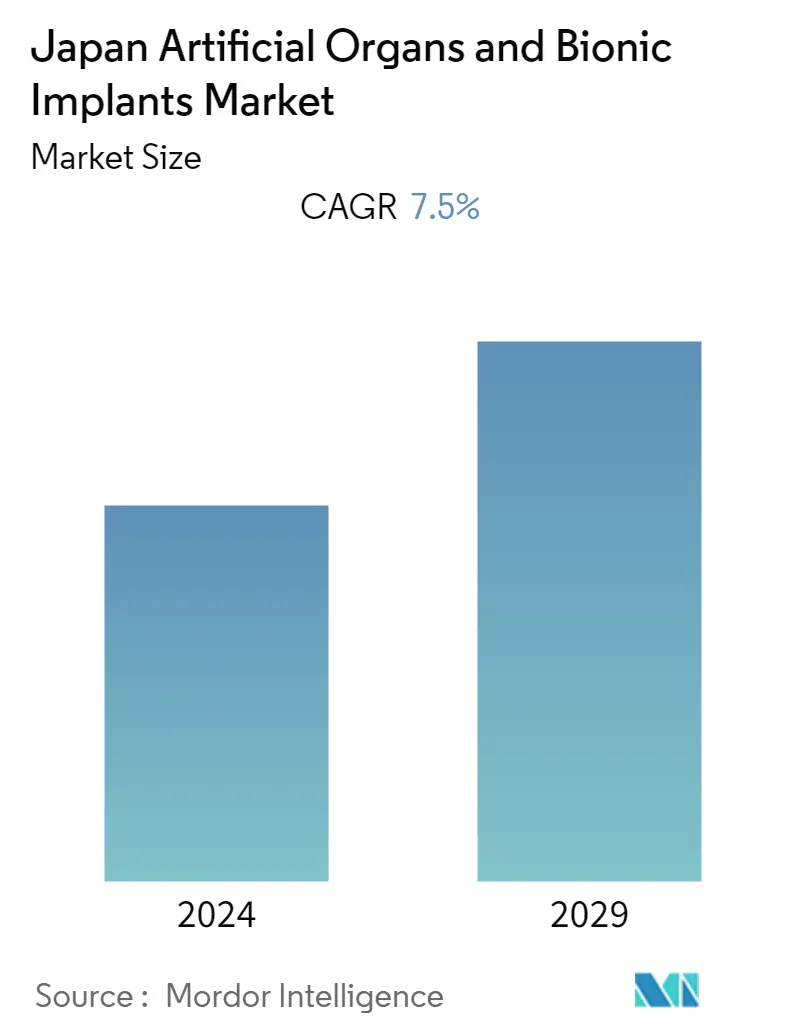Market Size of Japan Artificial Organs & Bionic Implants Industry

| Study Period | 2019 - 2029 |
| Base Year For Estimation | 2023 |
| Forecast Data Period | 2024 - 2029 |
| Historical Data Period | 2019 - 2022 |
| CAGR | 7.50 % |
Major Players
*Disclaimer: Major Players sorted in no particular order |
Japan Artificial Organs and Bionic Implants Market Analysis
The Japan artificial organs & bionic implants market is expected to register a CAGR of 7.5% over the forecast period.
The COVID-19 virus has impacted the global healthcare system and has significantly impacted the artificial organs and the bionics market. For instance, an article published by the journal Surgery Today in October 2021 reported that the COVID-19 pandemic has influenced Japan's transplantation surgical procedures and has affected transplantation activity significantly. The article also said that the COVID-19 pandemic suspended transplantation surgeries in Japan among 48% of the transplantation centers, including 78% of the kidney transplantation centers, and reduced the number of organ donations to 61%. Thus the pandemic slowed down organ transplantation surgeries in Japan.
Also, this market's growth was initially hampered by strict lockdowns, as lockdowns led to certain restrictions and scarcity of many goods. Still, with the increased clinical studies and the resumption of other services, the studied market witnessed significant growth. The factors driving the development of the studied market are increased incidence of disabilities and organ failures, rising geriatric population in Japan, high incidence of road accidents leading to amputations, and scarcity of donor organs.
The increasing number of organ failure cases in the geriatric population in Japan causes an increased demand for artificial organs. The growing prevalence of many chronic diseases in the aging population, like cholesterol, heart diseases, and chronic kidney disorder, poses a harmful effect on the organs, thereby increasing demand for organ transplantation. For instance, an article published by the Journal of Personalized Medicine in January 2022 reported that the estimated prevalence of CKD in Japan is 13%. Chronic kidney disorder leads to lifelong dialysis in many cases, which demands increasing organ transplantation, thus driving the growth of the studied market.
Similarly, the Statistical Handbook of Japan 2022 reported that in 2021, the senior population (65 years old and over) in Japan was 36.21 million, constituting 28.9% of the total population. Thus, the rising geriatric population is driving the growth of the studied market. With increasing aging, the immune system weakens, which causes an increased risk of chronic diseases that damage healthy functioning organs and demand for artificial organs, thereby driving the growth of the studied market.
Furthermore, the scarcity of organ donors in Japan caused by a high number of road accidents also drives increased demand for artificial organs. For instance, in October 2022, Japan Organ Transplant Network reported that as of September 2022, 15,573 people registered for organ transplantation, and only 82 people were available for this donation; that is, five donors per 1000 recipients are public, a still significant number of people will have to face scarcity of organs. Thus, this data demands an increasing need for artificial organ transplantation, thereby increasing the demand for artificial organs, thus driving the growth of the studied market.
Also, the news published by Japan Times on January 2022 reported that more than 300,000 people got injured in road accidents in 2021. Most of these accidents led to amputations. Thus, a high number of road accidents reported in the country lead to amputation, leading to increasing demand for artificial organs, thereby fueling the growth of the studied market in the country.
Thus, due to the increased incidence of disabilities and organ failures with the rising geriatric population and high incidence of road accidents, the market is expected to witness significant growth over the forecast period. However, expensive procedures and the risk of compatibility issues and malfunctions may slow down the development of the studied market.
Japan Artificial Organs and Bionic Implants Industry Segmentation
As per the report's scope, artificial organs and bionics are mechanical devices implanted into humans to substitute for a natural organ or offer support towards restoring certain bodily functions by which the patient may be able to return to normal life. The Japan artificial organs and bionic implants market is segmented by Product Type Artificial Organ (Artificial Heart, Artificial Kidney, Artificial Lungs, Cochlear Implants, and Other Organ Types), Bionics (Vision Bionics, Cardiac Bionics, Orthopedic Bionic, and Other Bionics). The report offers the value (in USD million) for the above segments.
| By Product Type | |||||||
| |||||||
|
Japan Artificial Organs & Bionic Implants Market Size Summary
The Japan artificial organs and bionic implants market is poised for significant growth, driven by an increasing incidence of disabilities and organ failures, a rising geriatric population, and a high number of road accidents leading to amputations. The market's expansion is supported by the growing demand for artificial organs due to the prevalence of chronic diseases among the elderly, such as cardiovascular and kidney disorders. The scarcity of donor organs further fuels the need for artificial solutions, as evidenced by the limited availability of organ donors compared to the number of individuals requiring transplants. Despite initial setbacks caused by the COVID-19 pandemic, which temporarily disrupted transplantation activities, the market has rebounded with the resumption of clinical studies and healthcare services.
Technological advancements and ongoing research are pivotal in propelling the market forward, particularly in the development of artificial hearts and orthopedic bionics. The artificial heart segment is expected to experience robust growth due to the increasing demand for heart disease interventions among the aging population. Innovations, such as the development of personal heart models and successful clinical trials, are enhancing the efficacy of artificial heart solutions. Similarly, the orthopedic bionics segment is benefiting from advancements in bionic bone technology and the rising need for solutions addressing road accident injuries and physical disabilities. The market is moderately consolidated, with key players like Abiomed, Medtronic, and Boston Scientific Corporation leading the charge in innovation and market presence.
Japan Artificial Organs & Bionic Implants Market Size - Table of Contents
-
1. MARKET DYNAMICS
-
1.1 Market Overview
-
1.2 Market Drivers
-
1.2.1 Increased Incidence of Disabilities and Organ Failures With Rising Geriatric Population
-
1.2.2 High Incidence of Road Accidents
-
-
1.3 Market Restraints
-
1.3.1 Expensive Procedures and Risk of Compatibility Issues and Malfunctions
-
-
1.4 Porter's Five Force Analysis
-
1.4.1 Threat of New Entrants
-
1.4.2 Bargaining Power of Buyers/Consumers
-
1.4.3 Bargaining Power of Suppliers
-
1.4.4 Threat of Substitute Products
-
1.4.5 Intensity of Competitive Rivalry
-
-
-
2. MARKET SEGMENTATION (Market Size by Value - USD million)
-
2.1 By Product Type
-
2.1.1 Artificial Organ
-
2.1.1.1 Artificial Heart
-
2.1.1.2 Artificial Kidney
-
2.1.1.3 Artificial Lungs
-
2.1.1.4 Cochlear Implants
-
2.1.1.5 Other Organ Types
-
-
2.1.2 Bionics
-
2.1.2.1 Vision Bionics
-
2.1.2.2 Cardiac Bionics
-
2.1.2.3 Orthopedic Bionic
-
2.1.2.4 Other Bionics
-
-
-
Japan Artificial Organs & Bionic Implants Market Size FAQs
What is the current Japan Artificial Organs & Bionic Implants Market size?
The Japan Artificial Organs & Bionic Implants Market is projected to register a CAGR of 7.5% during the forecast period (2024-2029)
Who are the key players in Japan Artificial Organs & Bionic Implants Market?
ABIOMED, Boston Scientific Corporation , Medtronic, Össur hf and Baxter International Inc. are the major companies operating in the Japan Artificial Organs & Bionic Implants Market.

